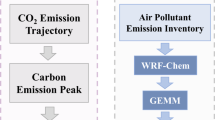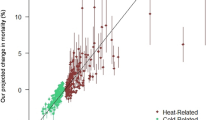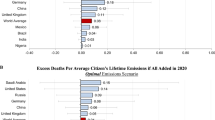Abstract
Climate mitigation can bring air quality and health co-benefits. How these health impacts might be distributed across countries remains unclear. Here we use a coupled climate–energy–health model to assess the country-varying health effects of a global carbon price across nearly 30,000 future states of the world (SOWs). As a carbon price lowers fossil fuel use, our analysis suggests consistent reductions in ambient fine particulate matter (PM2.5) levels and associated mortality risks in countries that currently suffer most from air pollution. For a few less-polluted countries, however, a carbon price can increase the mortality risks under some of the considered SOWs due to emissions increases from bioenergy use and land-use changes. These potential health co-harms are largely driven in our model by the scale and method of deforestation. A robust and quantitative understanding of these distributional outcomes requires improved representations of relevant deep uncertainties, country-specific characteristics and cross-sector interactions.
This is a preview of subscription content, access via your institution
Access options
Access Nature and 54 other Nature Portfolio journals
Get Nature+, our best-value online-access subscription
$29.99 / 30 days
cancel any time
Subscribe to this journal
Receive 12 digital issues and online access to articles
$119.00 per year
only $9.92 per issue
Buy this article
- Purchase on Springer Link
- Instant access to full article PDF
Prices may be subject to local taxes which are calculated during checkout





Similar content being viewed by others
Data availability
The dataset generated during and analysed in the current study is available from a public Zenodo repository (https://doi.org/10.5281/zenodo.6975580). All input data are available in the repository. The output of the GCAM ensemble is not available due to limited space, but the required outputs for the analysis and the production of the tables and the figures in this study are available in the repository.
Code availability
The GCAM model is available for download from https://github.com/JGCRI/gcam-core. Detailed model documentation is available online at http://jgcri.github.io/gcam-doc/index.html. The TM5-FASST model is available at http://tm5-fasst.jrc.ec.europa.eu/. Python (v3.6) and R(v3.6) are used for data analysis. The codes we use to process the data, calculate the health impacts and make the plots are available from a public Zenodo repository (https://doi.org/10.5281/zenodo.7894050).
References
Driscoll, C. T. et al. US power plant carbon standards and clean air and health co-benefits. Nat. Clim. Change 5, 535–540 (2015).
Murray, C. J. L. et al. Global burden of 87 risk factors in 204 countries and territories, 1990–2019: a systematic analysis for the Global Burden of Disease Study 2019. Lancet 396, 1223–1249 (2020).
Yang, H., Huang, X. & Westervelt, D. M. et al. Socio-demographic factors shaping the future global health burden from air pollution. Nat Sustain 6, 58–68 (2023).
Shetty, P. Grey matter: ageing in developing countries. Lancet 379, 1285–1287 (2012).
West, J. J. et al. Co-benefits of mitigating global greenhouse gas emissions for future air quality and human health. Nat. Clim. Change 3, 885–889 (2013).
IEA World Energy Statistics and Balances, World Energy Balances (IEA, accessed 21 January 2023); https://doi.org/10.1787/data-00512-en
Lelieveld, J. et al. Effects of fossil fuel and total anthropogenic emission removal on public health and climate. Proc. Natl Acad. Sci. USA 116, 7192–7197 (2019).
Shindell, D., Faluvegi, G., Seltzer, K. & Shindell, C. Quantified, localized health benefits of accelerated carbon dioxide emissions reductions. Nat. Clim. Change 8, 291–295 (2018).
Yang, H., Pham, A. T., Landry, J. R., Blumsack, S. A. & Peng, W. Emissions and health implications of Pennsylvania’s entry into the Regional Greenhouse Gas Initiative. Environ. Sci. Technol. 55, 12153–12161 (2021).
Owusu, P. A. & Asumadu-Sarkodie, S. A review of renewable energy sources, sustainability issues and climate change mitigation. Cogent Eng. 3, 1167990 (2016).
Hanssen, S. V. et al. The climate change mitigation potential of bioenergy with carbon capture and storage. Nat. Clim. Change 10, 1023–1029 (2020).
Hill, J. et al. Climate change and health costs of air emissions from biofuels and gasoline. Proc. Natl Acad. Sci. USA 106, 2077–2082 (2009).
Masera, O. R., Bailis, R., Drigo, R., Ghilardi, A. & Ruiz-Mercado, I. Environmental burden of traditional bioenergy use. Annu. Rev. Environ. Resour. 40, 121–150 (2015).
Skorupka, M. & Nosalewicz, A. Ammonia volatilization from fertilizer urea—a new challenge for agriculture and industry in view of growing global demand for food and energy crops. Agriculture 11, 822 (2021).
Popp, A. et al. Land-use futures in the shared socio-economic pathways. Glob. Environ. Change 42, 331–345 (2017).
Klimont, Z. et al. Global anthropogenic emissions of particulate matter including black carbon. Atmos. Chem. Phys. 17, 8681–8723 (2017).
Moallemi, E. A., Kwakkel, J., de Haan, F. J. & Bryan, B. A. Exploratory modeling for analyzing coupled human-natural systems under uncertainty. Glob. Environ. Change 65, 102186 (2020).
Calvin, K. et al. GCAM v5.1: representing the linkages between energy, water, land, climate, and economic systems. Geosci. Model Dev. 12, 677–698 (2019).
Van Dingenen, R. et al. TM5-FASST: a global atmospheric source–receptor model for rapid impact analysis of emission changes on air quality and short-lived climate pollutants. Atmos. Chem. Phys. 18, 16173–16211 (2018).
Burnett, R. T. et al. An integrated risk function for estimating the global burden of disease attributable to ambient fine particulate matter exposure. Environ. Health Perspect. 122, 397–403 (2014).
Cramton, P., Ockenfels, A. & Stoft, S. An international carbon-price commitment promotes cooperation. Econ. Energy Environ. Policy 4, 51–64 (2015).
Carbon Pricing Dashboard: Up-to-Date Overview of Carbon Pricing Initiatives (World Bank, accessed 15 January 2023); https://carbonpricingdashboard.worldbank.org/
Lamontagne, J. R. et al. Large ensemble analytic framework for consequence‐driven discovery of climate change scenarios. Earth’s Future 6, 488–504 (2018).
Dolan, F. et al. Modeling the economic and environmental impacts of land scarcity under deep uncertainty. Earth’s Future 10, e2021EF002466 (2022).
O’Neill, B. C. et al. The roads ahead: narratives for shared socioeconomic pathways describing world futures in the 21st century. Glob. Environ. Change 42, 169–180 (2017).
Dolan, F. et al. Evaluating the economic impact of water scarcity in a changing world. Nat. Commun. 12, 1915 (2021).
Birnbaum, A., Lamontagne, J., Wild, T., Dolan, F. & Yarlagadda, B. Drivers of future physical water scarcity and its economic impacts in Latin America and the Caribbean. Earth’s Future 10, e2022EF002764 (2022).
Markandya, A. et al. Health co-benefits from air pollution and mitigation costs of the Paris Agreement: a modelling study. Lancet Planet. Health 2, e126–e133 (2018).
Sampedro, J. et al. Health co-benefits and mitigation costs as per the Paris Agreement under different technological pathways for energy supply. Environ. Int. 136, 105513 (2020).
Ou, Y. et al. Can updated climate pledges limit warming well below 2 °C? Science 374, 693–695 (2021).
IPCC Climate Change 2022: Mitigation of Climate Change (eds Shukla, P.R. et al.) (Cambridge Univ. Press, 2022).
Fawcett, A. A. et al. Can Paris pledges avert severe climate change? Science 350, 1168–1169 (2015).
Anenberg, S. C. et al. Global air quality and health co-benefits of mitigating near-term climate change through methane and black carbon emission controls. Environ. Health Perspect. 120, 831–839 (2012).
IEA World Energy Outlook 2021 (IEA, 2021, accessed 4 June 2022); https://www.iea.org/reports/world-energy-outlook-2021
Lee, J. S. H. et al. Toward clearer skies: challenges in regulating transboundary haze in Southeast Asia. Environ. Sci. Policy 55, 87–95 (2016).
van der Werf, G. R. et al. Global fire emissions and the contribution of deforestation, savanna, forest, agricultural, and peat fires (1997–2009). Atmos. Chem. Phys. 10, 11707–11735 (2010).
Pedroso, N., Adams, C. & Murrieta, R. in Current Trends in Human Ecology (eds Lopes, P. & Begossi, A.) 12–34 (Cambridge Scholars Publishing, 2009).
Proskurina, S., Junginger, M., Heinimö, J., Tekinel, B. & Vakkilainen, E. Global biomass trade for energy— part 2: production and trade streams of wood pellets, liquid biofuels, charcoal, industrial roundwood and emerging energy biomass. Biofuels Bioprod. Bioref. 13, 371–387 (2019).
Commane, R. & Schiferl, L. D. Climate mitigation policies for cities must consider air quality impacts. Chem 8, 910–923 (2022).
Frank, S. et al. Reducing greenhouse gas emissions in agriculture without compromising food security? Environ. Res. Lett. 12, 105004 (2017).
Hejazi, M. I. et al. 21st century United States emissions mitigation could increase water stress more than the climate change it is mitigating. Proc. Natl Acad. Sci. USA 112, 10635–10640 (2015).
Wang, K., Yan, M., Wang, Y. & Chang, C.-P. The impact of environmental policy stringency on air quality. Atmos. Environ. 231, 117522 (2020).
Srikrishnan, V. et al. Uncertainty analysis in multi-sector systems: considerations for risk analysis, projection, and planning for complex systems. Earth’s Future 10, e2021EF002644 (2022).
Weitzman, M. L. Can negotiating a uniform carbon price help to internalize the global warming externality? J. Assoc. Environ. Resour. Econ. 1, 29–49 (2014).
Cullenward, D. & Victor, D. G. Making Climate Policy Work (Wiley, 2020).
Green, J. F. Does carbon pricing reduce emissions? A review of ex-post analyses. Environ. Res. Lett. 16, 043004 (2021).
Lee, D.-Y., Elgowainy, A., Kotz, A., Vijayagopal, R. & Marcinkoski, J. Life-cycle implications of hydrogen fuel cell electric vehicle technology for medium- and heavy-duty trucks. J. Power Sources 393, 217–229 (2018).
Harper, A. B. et al. Land-use emissions play a critical role in land-based mitigation for Paris climate targets. Nat. Commun. 9, 2938 (2018).
Sanchez, D. L., Johnson, N., McCoy, S. T., Turner, P. A. & Mach, K. J. Near-term deployment of carbon capture and sequestration from biorefineries in the United States. Proc. Natl Acad. Sci. USA 115, 4875–4880 (2018).
Kang, Y. et al. Bioenergy in China: evaluation of domestic biomass resources and the associated greenhouse gas mitigation potentials. Renew. Sustain. Energy Rev. 127, 109842 (2020).
Vohra, K. et al. Global mortality from outdoor fine particle pollution generated by fossil fuel combustion: results from GEOS-Chem. Environ. Res. 195, 110754 (2021).
Liu, S. et al. Spatial-temporal variation characteristics of air pollution in Henan of China: localized emission inventory, WRF/Chem simulations and potential source contribution analysis. Sci. Total Environ. 624, 396–406 (2018).
Hartin, C. A., Patel, P., Schwarber, A., Link, R. P. & Bond-Lamberty, B. P. A simple object-oriented and open-source model for scientific and policy analyses of the global climate system–Hector v1.0. Geosci. Model Dev. 8, 939–955 (2015).
Peng, W. et al. Climate policy models need to get real about people—here’s how. Nature 594, 174–176 (2021).
Stern, P. C., Dietz, T., Nielsen, K. S., Peng, W. & Vandenbergh, M. P. Feasible climate mitigation. Nat. Clim. Change 13, 6–8 (2023).
Riahi, K. et al. The Shared Socioeconomic Pathways and their energy, land use, and greenhouse gas emissions implications: an overview. Glob. Environ. Change 42, 153–168 (2017).
Calvin, K. et al. The SSP4: a world of deepening inequality. Glob. Environ. Change 42, 284–296 (2017).
Zhao, X. et al. The impact of agricultural trade approaches on global economic modeling. Glob. Environ. Change 73, 102413 (2022).
Plevin, R. J. et al. Choices in land representation materially affect modeled biofuel carbon intensity estimates. J. Clean. Prod. 349, 131477 (2022).
Train, K. E. Discrete Choice Methods with Simulation (Cambridge Univ. Press, 2009).
McFadden, D. in Frontiers in Econometrics (ed. Zarembka, P.) 105–142 (Academic Press, 1973).
Boden, T. A., G. Marland, & R. J. Andres. Global, regional, and national fossil-fuel CO2 emissions. Carbon Dioxide Information Analysis Center https://doi.org/10.3334/CDIAC/00001_V2010 (2010).
Kyle, G. P. et al. GCAM 3.0 Agriculture and Land Use: Data Sources and Methods (OSTI.GOV, 2011); https://doi.org/10.2172/1036082
Ou, Y. et al. Deep mitigation of CO2 and non-CO2 greenhouse gases toward 1.5 °C and 2 °C futures. Nat. Commun. 12, 6245 (2021).
Rao, S. et al. Future air pollution in the Shared Socio-economic Pathways. Glob. Environ. Change 42, 346–358 (2017).
Krol, M. et al. The two-way nested global chemistry-transport zoom model TM5: algorithm and applications. Atmos. Chem. Phys. 5, 417–432 (2005).
Crippa, M. et al. Gridded emissions of air pollutants for the period 1970–2012 within EDGAR v4.3.2. Earth Syst. Sci. Data 10, 1987–2013 (2018).
Hughes, B. B. et al. Projections of global health outcomes from 2005 to 2060 using the International Futures integrated forecasting model. Bull. World Health Organ. 89, 478–486 (2011).
Becker, R. A., Wilks, A. R. & Brownrigg, R. mapdata: extra map databases. R version 2.3.1 (2022); https://CRAN.R-project.org/package=mapdata
Acknowledgements
X.H., V.S. and W.P. acknowledge the support from the National Science Foundation under grant number 2125293. We also thank the seed grant support from Penn State Institutes of Energy and the Environment and Institute for Computational and Data Sciences. K.K.’s contribution was supported by Dartmouth College. We thank E. Mayfield, L. Lynd, S. Wishbone and J. Shiwang for invaluable inputs. All errors and opinions are those of the authors and not of the funding entities.
Author information
Authors and Affiliations
Contributions
X.H., V.S., K.K. and W.P. designed the study and interpreted the data. V.S. and J.L. constructed the state of the world ensemble. X.H. led the data analysis and produced the figures. All authors co-wrote the paper.
Corresponding author
Ethics declarations
Competing interests
The authors declare no competing interests.
Peer review
Peer review information
Nature Sustainability thanks Govinda R. Timilsina and the other, anonymous, reviewer(s) for their contribution to the peer review of this work.
Additional information
Publisher’s note Springer Nature remains neutral with regard to jurisdictional claims in published maps and institutional affiliations.
Supplementary information
Supplementary Information
Supplementary Figs. 1–26, Discussion and Tables 1–11.
Rights and permissions
Springer Nature or its licensor (e.g. a society or other partner) holds exclusive rights to this article under a publishing agreement with the author(s) or other rightsholder(s); author self-archiving of the accepted manuscript version of this article is solely governed by the terms of such publishing agreement and applicable law.
About this article
Cite this article
Huang, X., Srikrishnan, V., Lamontagne, J. et al. Effects of global climate mitigation on regional air quality and health. Nat Sustain 6, 1054–1066 (2023). https://doi.org/10.1038/s41893-023-01133-5
Received:
Accepted:
Published:
Issue Date:
DOI: https://doi.org/10.1038/s41893-023-01133-5
This article is cited by
-
Substantially reducing global PM2.5-related deaths under SDG3.9 requires better air pollution control and healthcare
Nature Communications (2024)
-
Trade-offs in land-based carbon removal measures under 1.5 °C and 2 °C futures
Nature Communications (2024)
-
Measuring the synergy of air pollution and CO2 emission in Chinese urban agglomerations: an evaluation from the aggregate impact and correlation perspectives
Stochastic Environmental Research and Risk Assessment (2024)
-
Assessing the sustainability of socio-economic boundaries in China: a downscaled “safe and just space” framework
npj Climate Action (2023)
-
Carbon pricing reduces inequality in pollution hazards
Nature Reviews Earth & Environment (2023)



